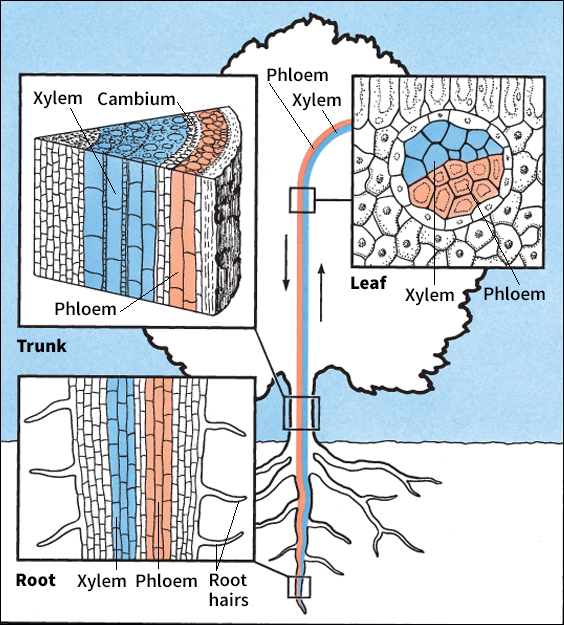Sap is the liquid found in the stems, roots, and leaves of plants. Seed plants contain two types of sap, cell sap and vascular sap. Some plants also produce other kinds of saps when they are cut or injured.
Cell sap.
Each plant cell contains a saclike structure, called a vacuole, that is filled with cell sap. The vacuole can take up most of the space within the cell. Cell sap is released when plant cells are broken or crushed. The cell sap of the sugar beet and the sugar cane contains much sugar. These plants are the chief sources of commercial sugar. Sugar also accumulates in the cell sap of many fruits as they ripen.
Vascular sap
flows through plants in specialized tissues called xylem << ZY lehm >> and phloem << FLOH ehm >> . The xylem consists of cells that carry one kind of sap up from the roots, through the stem, and to the leaves. This sap consists of water and dissolved minerals. It is used by the leaves to produce another kind of sap that the plant uses for food. This second sap, made up of sugars dissolved in water, is transported from the leaves to other parts of the plant by cells in the phloem.

The water and minerals in the xylem are absorbed from the soil by a plant’s many root tips in a process called osmosis. Each root tip has an area called the apical meristem that produces new cells. Most of the water and minerals are absorbed by threadlike root hairs that grow behind the apical meristems.
Once in the root, sap moves between cells and from cell to cell until it passes into the xylem. Pressure created by the root cells during osmosis then pushes the sap in the xylem up toward the leaves. At the same time, water is constantly lost by evaporation through tiny pores in the leaves. This process is called transpiration. As the leaf cells lose water, the evaporating water molecules create a force that pulls more sap upward. This extra pull is needed to draw water to the leaves at the top of a plant.
The leaves use energy from the sun to combine water and carbon dioxide into sugars that the plant needs for food in a process called photosynthesis. As molecules of sugar accumulate, they move out of leaf cells and into the phloem. Water enters the phloem by osmosis from surrounding cells and the xylem. As a result, pressure builds up in the phloem and moves the sap downward to the stems and roots. There, the sugar molecules are converted into starch and are stored. Some insects, such as aphids and scale insects, use their sucking mouthparts to pierce the stems of plants and obtain the sap in phloem for food.
In trees and other woody plants, a layer of tissue inside the trunk produces new layers of phloem and xylem each year. This layer of tissue is called the cambium. The xylem grows inward from the cambium, and phloem grows outward from the cambium. The phloem forms part of the bark and is constantly being shed. The xylem, which is a tree’s wood, accumulates in the central part of the trunk.
As a tree matures, the oldest wood no longer transports water and minerals. This dead wood, called heart-wood, supports the tree and holds it upright. The wood that surrounds it, called sapwood, carries sap from the roots to the leaves. In the spring, stored sugars are carried upward in the sapwood to the growing leaves. At this time of the year, people tap holes in the sapwood of sugar maples to collect the sweet sap used to make maple syrup.
Other saps.
Some plants release special saps when they are wounded. For example, milkweeds produce a liquid called latex when their stems are cut or broken. This liquid is usually white, but also may be yellow or red. Rubber trees produce a white latex that flows out of the trunk when it is cut. This latex is used to make rubber. Pine trees produce a gummy fluid called resin that oozes out when the stems, leaves, or bark are damaged. Latexes and resins are not true saps because they are not carried in xylem or phloem tissues. They are stored and released by other specialized plant structures.
